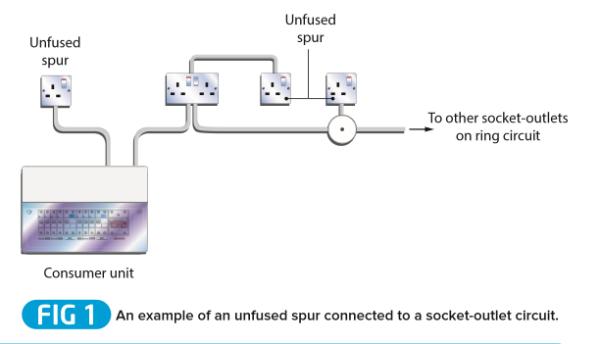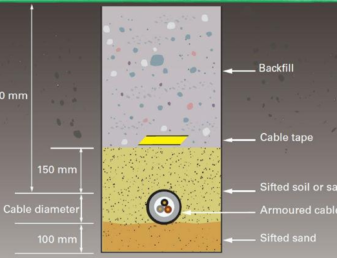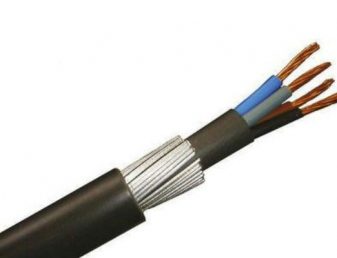This article provides guidance on how to connect items of equipment to socket-outlet circuits.
Socket-outlets are typically supplied by either a ring or a radial final circuit. In either case, a number of items of permanently connected equipment may also be supplied by the circuit. Such equipment should preferably be of a rating not exceeding 2 kW. The choices available to the electrician for connecting items of equipment to socket-outlet circuits are varied and each one requires some judgement to be made with respect to local conditions.
Permanently connected equipment may be connected directly to a ring final circuit using a fused connection unit incorporating a BS 1362 fuse (not exceeding 13 A) or a Type B or C circuit-breaker (not exceeding 16 A) complying with BS EN 60898 or BS EN 61009-1, or BS EN 60947-2. In the case of some existing installations, Type 1, 2 or 3 MCBs complying with BS 3871 may still be encountered.
A switch should be provided where a fixed or stationary appliance that may give rise to a hazard in normal use, is connected to the supply other than by a plug and socket-outlet.
Socket-outlets and fused connection units may be connected to the circuit directly or via a spur.
Regulation 411.3.3 requires that additional protection by means of an RCD with a rated residual operating current (IΔn) not exceeding 30 mA and an operating time not exceeding 40 ms at a residual current of 5 IΔn must be provided for socket-outlets with a rated current not exceeding 20 A. An exception is permitted for a specific labelled or otherwise suitably identified socket-outlet provided for the connection of a particular item of equipment, such as a freezer.
The number and positions of socket-outlets should be such as to ensure compliance with Regulation 553.1.7. This regulation stipulates that where mobile equipment is likely to be used, sufficient provision, in terms of number of socket-outlets and indeed the location of such, should be made to allow mobile equipment to be fed from an adjacent and conveniently accessible socket-outlet.
Due account should be taken of the length of flexible cable normally fitted to portable appliances and luminaires when considering such provision.
Spurs
A spur is a branch from a final circuit (Part 2 of BS 7671 refers). A spur may be either:
• unfused or
• fused.
Unfused spur
An unfused spur consists of a conductor, of suitable current-carrying capacity, connected to the terminals of the circuit’s overcurrent protective device in the consumer unit, or directly to either the terminals of an accessory such as a socket-outlet or a junction box without further overcurrent protection being provided at the point of connection (See Fig. 1).
For radial final circuits, the current-carrying capacity of conductors, corrected for the particular installation conditions, (Iz) used for an unfused spur, must be at least equal to the rated current (In) of the protective device of the circuit.
In the case of ring final circuits, copper conductors should have a minimum cross-sectional area of 2.5 mm2. For conductors of two-core mineral insulated cables, a minimum CSA of 1.5 mm2 applies. Additionally, in either case, the current carrying capacity (Iz) of the live conductors should not be less than 20 A (Regulation 433.1.103).
Only one unfused spur, supplying either a single 1-gang or 2-gang socket-outlet, should be connected to any accessory forming a part of the circuit (Appendix 15 of BS 7671 refers).
In the case of a ring final circuit, each unfused spur may only feed one single or one double socket-outlet, or a single item of current-using equipment.

Fused spur
A fused spur originates at a fused connection unit to BS 1363-4, which may be of the switched or unswitched type as can be seen in Fig. 2.
Conductors used for fused spurs should have an adequate current-carrying capacity for the connected load and is not limited to a cross-sectional area of 2.5 mm2. The fused spur is protected by a cartridge fuse to BS 1362. The rating of a fuse protecting a fused spur is determined from the total current demand of the spur, up to a maximum of 13 A. The current rating of the fuse in the unit is not to exceed the effective current-carrying capacity of the cable forming the spur.
The number of socket-outlets supplied by a fused spur is unlimited. However, an assessment should be made to ensure that the current demand of the equipment, connected via the socket-outlets forming part of the fused spur, does not exceed the rating of the fuse in the connection unit in normal use.
Permanently connected loads
A radial circuit dedicated to a particular load is generally provided where the operating current of the load is such that it would ‘dominate’ a circuit. For example, in most cases, a fixed electric heater rated at about 2 kW or more is served by a dedicated circuit (See Fig. 3).

Where a number of items of current-using equipment are served by a common circuit, disconnection of all the items will occur if the circuit protective device operates. Where disconnection of an item of equipment under such circumstances is likely to cause inconvenience or danger, a dedicated circuit should be provided for that equipment so that disconnection occurs only in the event of a fault attributable to that equipment or its associated circuit.
Information about the ELECSA Domestic Installers schemes, visit www.elecsa.co.uk or call 0333 321 8220





